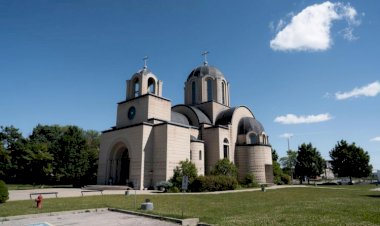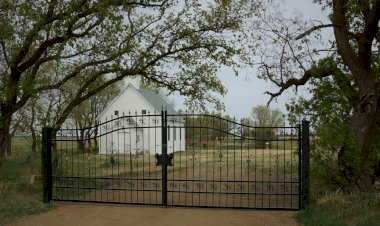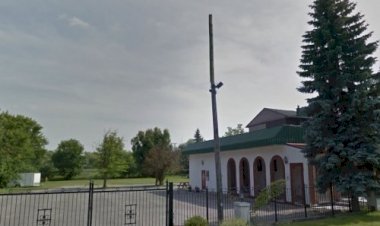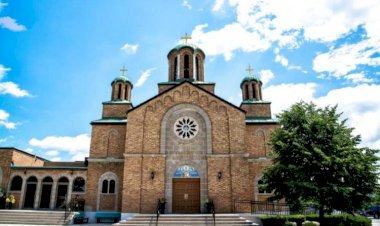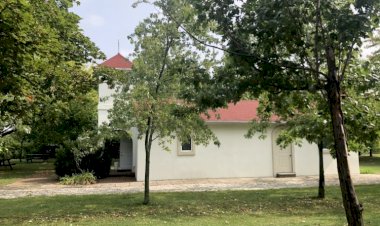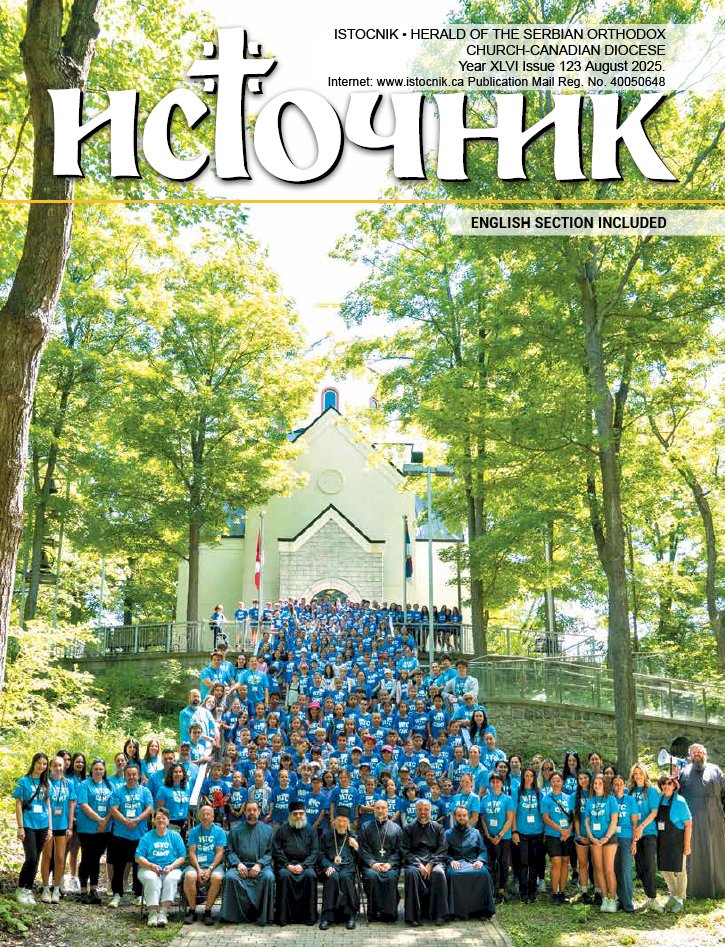Saint Sava Church, Winnipeg
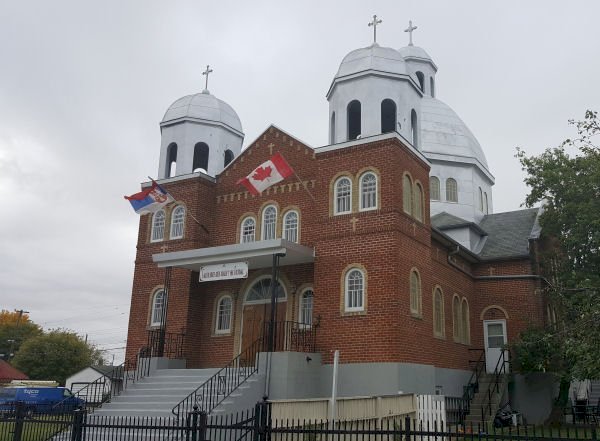
Saint Sava Church, Winnipeg
Address: 580 Talbot Avenue, Winnipeg MB, R2L 0R6
Website: www.instagram.com/saintsavawinnipeg

Priest: Fr. Georgije Tubonjic
Phone number: 431 279 6776
Email: georgije1@gmail.com
Father Georgije Tubonjic was born on May 6, 1997 in Ingolstadt (Germany), to parents Drago and Zorka (née Skopljak). He has two sisters: Dragana, married Radmanovic, and Dijana, married Filipovic. In March 1999, as a baby, he moved to Canada with his family. He received his primary education at the Lester B. Pearson School in Waterloo, which he graduated from in 2010, and then enrolled in Bluevale Collegiate Institute, also in Waterloo. From early on in his childhood, he grew up in the abode of the Holy Great Martyr George Church in Waterloo, where he actively participated in liturgical life and helped at the altar. With great love for the Church and his priestly vocation, in 2012, with the blessing of His Grace Bishop of Canada Georgije, he enrolled in the Theological Seminary of Saint Petar of Dabar-Bosnia in Foca. He graduated from the seminary in 2017, after which he continued his studies at the Saint Sava Theological Faculty in Libertyville, Illinois, which he graduated from in 2021. In the same year, on August 8, he entered into the Holy Sacrament of marriage with Marijana, née Svrdlin, from Kitchener. With the blessing of His Eminence Bishop of Canada Mitrofan, he was ordained to the rank of deacon on October 24, 2021, and to the rank of priest on the feast of the Holy Three Hierarchs, February 12, 2022. With the blessing of Bishop Mitrofan, he was appointed parish priest of the Saint Sava Church in Winnipeg, Manitoba, on June 1, 2022, where he still serves today. He and his wife Marijana have two sons – Jovan and Gavrilo.
History
Beginnings
About fifty Serbian families lived in Winnipeg at the beginning of World War I – a small but significant ethnic pioneer community in western Canada at the time. Serbs in that part of Canada also worked to raise funds to help their struggling homeland. From 1920 until the start of World War II, Serbian immigrants began to arrive from the regions of the former Austrian Empire (Hungary, Bosnia, Romania) and the Ottoman Empire (Kosovo, Macedonia) in increasing numbers, slowly increasing the Serbian population of Winnipeg. The next major wave of immigration came after World War II with the arrival of Serbian émigrés who fought under the command of General Dragoljub Mihailovic. In the years following World War II, Serbs in Winnipeg asked a Russian priest to serve in a rented, old wooden Orthodox church in St. Boniface – an Indian and Métis suburb of Winnipeg. The Serbian National Defense, headquartered in Hamilton, had a branch in Winnipeg and was the only Serbian organization in the city until February 10, 1965. Then, at the request of a group of Serbian women – Mira Miloica, Zivana Markovic, Marija Teslic, Soka Banjeglav, Sofija Dubec, Persida Cubarevic, Manda Potkonjak, Ljubica Radonjic, Mica Radosavljevic and Marta Vucinic – the Circle of Serbian Sisters was founded and registered. The two organizations began working together to maintain the Serbian Orthodox faith, Serbianness and Serbian customs. They organized various gatherings, a school for children, parties, picnics and various cultural and artistic programs. Since the Serbian National Defense was an exclusively political organization, when new emigrants arrived in Winnipeg, the idea came up to establish a new organization that would not be political and that would operate under a new charter and new management. Guided by this idea, and having before them the growth of the Serbian colony in Regina under the auspices of the Serbian Orthodox Church, several Serbs met on December 24, 1967, at the house of Mr. Risto Pajic, and decided to gather all the Serbs of the city of Winnipeg for one meeting in order to officially register. In a short time, this gathering was organized. On December 31, 1967, about fifteen Serbs gathered at the house of Dragutin Adamovic to establish an Orthodox organization. On the same day, the Serbian Orthodox Community was founded with several rules that also constituted the organization's first constitution. The first board of the Serbian Orthodox Community for 1968 consisted of: Zivan Milovanovic, Bogdan Radonjic, Rade Bijelic, Dragutin Adamovic, Risto Pajic, Vaso Kovacevic, president Mihajlo Jovanovic, and treasurer Adam Carevic.
With the establishment of the Serbian Orthodox Community, the Serbian National Defense ceased to function. At the annual meeting on November 3, 1968, the members of the Serbian Orthodox Community elected a new board for 1969. The purchase of the church was first discussed at the annual meeting of the Serbian Orthodox Community membership on November 9, 1969. The majority of members advocated for the purchase of the church and had already raised money for that purpose. At the same meeting, a new board for 1970 was elected. The 1970 Serbian Orthodox Community Board of Directors began working together with the Circle of Serbian Sisters to preserve the Serbian faith and customs, and together they organized a celebration of the Slava of Saint Sava. In May 1970, the minutes of the Serbian Orthodox Community session state that a joint session of the Serbian Orthodox Community and the Circle of Serbian Sisters was held in a hall that the Serbs had purchased from the Presbyterians at 599 Deniset Street which had become the property of the Serbian Orthodox Community. This was the first building that the Serbs in Winnipeg had purchased for the purpose of fulfilling their religious customs. By the will of God, on August 12, 1970, the Serbian people in Winnipeg were visited for the first time by the Bishop of Eastern America and Canada, Dr. Sava (Vukovic), accompanied by the priest Vladimir Milinkovic and the protodeacon Dr. Nedeljko Grgurevic. At a meeting between Bishop Sava and the Serbs from Winnipeg at the Serbian Home, the Bishop advised them to transform the Serbian Orthodox Community into a Church and School Congregation and thus officially become part of the Serbian Orthodox Church with its headquarters in Belgrade. The Board of Directors of the Serbian Orthodox Community, at its meeting on March 19, 1972, decided to transform the Serbian Orthodox Community into a Church and School Congregation whose patron saint would be Saint Sava. This meeting was attended by the parish priest of Calgary, Fr. Bogdan Zjalic, who was appointed administrator of the newly formed Winnipeg municipality by Bishop Sava. The parish newspaper Svetosavlje was founded in 1972.
During those years, 1972 and 1973, Fr. Bogdan Zjalic came to Winnipeg several times as an administrator. He served sacred services, taught the Circle of Serbian Sisters and the board members of the Church and School Congregation how to celebrate their patron saints, and together with them preserved from oblivion everything related to the Serbian Orthodox faith and Serbian customs. Already in 1974, on Palm Sunday, Bishop Sava and Fr. Bogdan Zjalic visited the Church and School Congregation of Saint Sava in Winnipeg. On that occasion, the Bishop appointed Fr. Srboljub Jockovic as the first parish priest of Winnipeg. That same year, Fr. Srboljub organized an active school for children to study religious education and the Serbian language. Fr. Srboljub also opened a church radio in Winnipeg. Only a year later, Bishop Sava came again to visit the newly founded community and to support and instruct its members on their journey. Fr. Srboljub remained in the Winnipeg parish for two full years, before being succeeded by Fr. Zivorad Gavrilovic in the summer of 1976. During Fr. Zivorad’s tenure, the Saint Sava Church and School Congregation made great progress. For the first time, in 1977, this church community held a week-long multicultural performance called Mala Folklorama. In January 1978, a new building was purchased from the Salvation Army at 226 Atlantic Avenue. The hardworking Serbs of Winnipeg converted it into a church building, with a hall and an apartment for the priest and his family. Petar Damjanovic became the godfather of the new church. The Serbs bought the building for $41,000 and worked tirelessly and harmoniously to convert it for church purposes, as well as to expand the hall and add a bell tower. That same year, at the assembly of the members of the Church and School Congregation on February 18, 1978, a decision was made by a majority vote to sell the old building on Deniset Street, purchased in 1969. Father Zivorad remained at the head of this Church and School Congregation until October 1980, when he left to take up the position of parish priest in Windsor. After a short time, in February 1981, the vacant parish of Saint Sava in Winnipeg received a new parish priest, Fr. Nikodim Pribojan. During the service of Fr. Nikodim from 1981 to 1986, a prominent place in the work of the church community was given to organizing folklore. It is also necessary to emphasize that at that time the most attention was paid to the progress of the folklore group Kolo (founded in 1978) as well as to the school of Serbian language and religious education.
After the departure of Fr. Nikodim, Fr. Bozo Bakajlic came to the Winnipeg parish and remained there until 1988. Then Fr. Zivorad Subotic served in the Saint Sava Church (1988–1990). Until 1992, the parish did not have a permanent priest and the parish was administered by Fr. Mirko Malinovic from Regina. This was a period of crisis in this colony – the number of Serbs had decreased, and the financial situation was such that they were unable to support a priest. With the intention of strengthening faith among the people and strengthening the church through constant prayer and gatherings, despite the difficult situation, Bishop Georgije appointed Fr. Vitomir Kostic as parish priest in 1992.
Present church
The Church and School Congregation experienced a real period of growth and stability with the appointment of the young priest Fr. Dusan Gnjatic in 1994. In a short time, church life among the Serbs in Winnipeg revived, and at an extraordinary membership meeting on February 5, 1997, a decision was made to purchase a new church. The Ukrainian Catholic Church, built from 1948 to 1952, at 580 Talbot Avenue, was chosen. The original design of the church was done by the famous church architect from Manitoba Philip Ruh. At the same meeting, part of the money for the church was already collected. The church and parish house were purchased for $195,000, of which $61,000 was collected at the aforementioned meeting. $50,000 was borrowed from the Holy Trinity Serbian Orthodox Church in Regina, and the rest of the debt was paid off with a bank loan of $75,000. The Provincial Monuments Preservation Office also provided $20,000 to renovate the hall below the church. The interior of the church was remodeled for Orthodox use. The godfather of the newly purchased church was Djuro Djordje Srbljanin, and there is a curious fact about this godfathership. The godfather was only twelve years old and is probably the youngest godfather of a Serbian church in the whole world. The newly purchased church is dedicated to the Assembly of the Serbian Saints, but in documents it is still registered under the Saint Sava Church and School Congregation. For now, it is the only Serbian Orthodox church in Manitoba.
On May 1, 1999, Fr. Radovan Maric was appointed to the Winnipeg parish. This was a time when many refugees from our homeland were coming to Winnipeg. In less than three years, in addition to preserving religious and cultural life, significant changes were made in the life of this parish. One of the main things that was done was the repayment of a bank loan, which at that time amounted to $46,000. This is a large sum for the Winnipeg colony – it is approximately the same as the total annual budget of this Church and School Congregation – but funds are always found for a God-pleasing work, even to exceed initial goals. Thus, in 2000, the debt to the church in Regina was repaid, and funds were found to replace the roof of the church, which was about fifty years old, in the same year. In addition, the heating in the church hall was changed under the leadership, and at the personal expense, of Mr. Petar Damjanovic. At the same time, intensive work is being done to preserve and improve spiritual content. It is worth mentioning that the folklore group Beograd (formerly Gracanica and Kolo) is still operating successfully, and today it has about 75 members. In 2000, a renewed Serbian language school began operating. And of course, one of the pillars of the church is still the Circle of Serbian Sisters – the oldest active Serbian organization in Winnipeg – which today has about twenty hardworking sisters.



